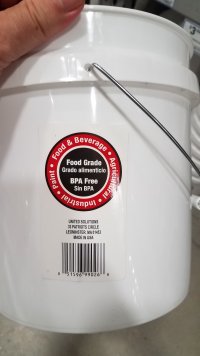I'm starting a mixed berry/fruit melomel and I wanted to documents its process, since I'm a little unsure how it's going to go. I'm trying out more technical processes for this batch (I've been very loose and guess-y for all my previous ones), though I'm still not following an existing recipe. Hopefully what I've created actually works : )
- 4 lbs Dark Sweet Cherries
- 2 1/4 lbs Red Raspberries
- 2 lbs Blackberries
- 2 2/3 lbs Wildflower Honey
- 1/3 lbs Buckwheat Honey
- 1/4 to 1/2 tsp Pectic Enzyme
- 1 Campden tablet
- 3.8 grams Go-Ferm (approx.)
- 1/4 tsp Bentonite
- 5 gram packet of Lalvin 71b yeast
- 3.1 grams Fermaid O (approx.), staggered
- However much additional spring water is needed
I turned all of the fruit (plus a small amount of spring water to ease the process) into juice/syrup on the stove over the course of a couple hours, yielding a bit over half a gallon. I stored this in a sanitized gallon jug overnight on a crushed campden tablet and approx. 1/4 tsp pectic enzyme, shaking well to hopefully add some oxygen to the must since I don't have good tools for oxygenating. The (approximate) SG of the fruit syrup alone was between 1.050 and 1.060 based on the numerous measurement attempts I made, none of them quite the same. Viscosity probably played a role in inaccurate measurements.
I added as close to 3 total pounds of honey as I could, as the 1/3 lb buckwheat was what remained of 1 lb container and I didn't have an accurate scale on hand; eyeballs are going to have to be sufficient. The SG of the honey + fruit juice mixture was more reliably measured at 1.150 multiple times. Combining the fruit juice and the honey nearly filled my 1 gallon primary fermenter, and the additional spring water used to prepare the remaining ingredients pushed it even closer. This batch is the first I've fashioned an overflow valve for because of that. I added the Bentonite and Go-Ferm to the must after a thorough mix of the initial fermentables, plus a touch more pectic enzyme to ensure I had enough to tackle the high volume of fruit matter, plus the rehydrated 71B before sealing with the makeshift overflow valve.
I'm following the instructions from the TONSA calculator for Go-Ferm and Fermaid O addition, using the high estimate of 1.060 for the fruit gravity and the probably-accurate 1.150 for the total gravity, as well as its staggered nutrient addition schedule.
- 4 lbs Dark Sweet Cherries
- 2 1/4 lbs Red Raspberries
- 2 lbs Blackberries
- 2 2/3 lbs Wildflower Honey
- 1/3 lbs Buckwheat Honey
- 1/4 to 1/2 tsp Pectic Enzyme
- 1 Campden tablet
- 3.8 grams Go-Ferm (approx.)
- 1/4 tsp Bentonite
- 5 gram packet of Lalvin 71b yeast
- 3.1 grams Fermaid O (approx.), staggered
- However much additional spring water is needed
I turned all of the fruit (plus a small amount of spring water to ease the process) into juice/syrup on the stove over the course of a couple hours, yielding a bit over half a gallon. I stored this in a sanitized gallon jug overnight on a crushed campden tablet and approx. 1/4 tsp pectic enzyme, shaking well to hopefully add some oxygen to the must since I don't have good tools for oxygenating. The (approximate) SG of the fruit syrup alone was between 1.050 and 1.060 based on the numerous measurement attempts I made, none of them quite the same. Viscosity probably played a role in inaccurate measurements.
I added as close to 3 total pounds of honey as I could, as the 1/3 lb buckwheat was what remained of 1 lb container and I didn't have an accurate scale on hand; eyeballs are going to have to be sufficient. The SG of the honey + fruit juice mixture was more reliably measured at 1.150 multiple times. Combining the fruit juice and the honey nearly filled my 1 gallon primary fermenter, and the additional spring water used to prepare the remaining ingredients pushed it even closer. This batch is the first I've fashioned an overflow valve for because of that. I added the Bentonite and Go-Ferm to the must after a thorough mix of the initial fermentables, plus a touch more pectic enzyme to ensure I had enough to tackle the high volume of fruit matter, plus the rehydrated 71B before sealing with the makeshift overflow valve.
I'm following the instructions from the TONSA calculator for Go-Ferm and Fermaid O addition, using the high estimate of 1.060 for the fruit gravity and the probably-accurate 1.150 for the total gravity, as well as its staggered nutrient addition schedule.






























![Craft A Brew - Safale S-04 Dry Yeast - Fermentis - English Ale Dry Yeast - For English and American Ales and Hard Apple Ciders - Ingredients for Home Brewing - Beer Making Supplies - [1 Pack]](https://m.media-amazon.com/images/I/41fVGNh6JfL._SL500_.jpg)


























